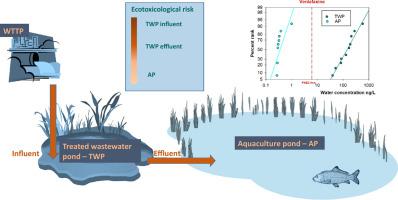Journal of Hazardous Materials ( IF 12.2 ) Pub Date : 2021-07-27 , DOI: 10.1016/j.jhazmat.2021.126712 Ganna Fedorova 1 , Roman Grabic 1 , Kateřina Grabicová 1 , Jan Turek 1 , Tuyen Van Nguyen 1 , Tomas Randak 1 , Bryan W Brooks 2 , Vladimir Zlabek 1

|
Aquaculture is increasing at the global scale, and beneficial reuse of wastewater is becoming crucial in some regions. Here we selected a unique tertiary treatment system for study over a one-year period. This experimental ecosystem-based approach to effluent management included a treated wastewater pond (TWP), which receives 100% effluent from a wastewater treatment plant, and an aquaculture pond (AP) that receives treated water from the TWP for fish production. We examined the fate of a wide range of pharmaceutically active compounds (PhACs) in this TWP-AP system and a control pond fed by river water using traditional grab sampling and passive samplers. We then employed probabilistic approaches to examine exposure hazards. Telmisartan, carbamazepine, diclofenac and venlafaxine, exceeded ecotoxicological predicted no effect concentrations in influent wastewater to the TWP, but these water quality hazards were consistently reduced following treatment in the TWP-AP system. In addition, both grab and passive sampling approaches resulted in similar occurrence patterns of studied compounds, which highlights the potential of POCIS use for water monitoring. Based on the approach taken here, the TWP-AP system appears useful as a tertiary treatment step to reduce PhACs and decrease ecotoxicological and antibiotic resistance water quality hazards prior to beneficial reuse in aquaculture.
中文翻译:

水产养殖用水回用:一年研究中池塘处理系统对药物的去除效果和水生危害减少的比较
水产养殖在全球范围内不断增加,废水的有益再利用在某些地区变得至关重要。在这里,我们选择了一个独特的三级处理系统进行为期一年的研究。这种基于生态系统的实验性污水管理方法包括一个处理过的污水池 (TWP),它接收来自污水处理厂的 100% 流出物,以及一个水产养殖池 (AP),它接收来自 TWP 的处理过的水用于鱼类生产。我们使用传统的抓取采样和被动采样器检查了该 TWP-AP 系统和由河水供给的对照池塘中各种药物活性化合物 (PhAC) 的命运。然后,我们采用概率方法来检查暴露危害。替米沙坦、卡马西平、双氯芬酸和文拉法辛,超过生态毒理学预测的进水废水中对 TWP 没有影响的浓度,但在 TWP-AP 系统中处理后,这些水质危害持续减少。此外,抓取和被动采样方法导致所研究化合物的出现模式相似,这突出了 POCIS 用于水监测的潜力。基于此处采用的方法,TWP-AP 系统似乎可用作三级处理步骤,以在水产养殖中有益再利用之前减少 PhAC 并减少生态毒理学和抗生素耐药性水质危害。这突出了 POCIS 用于水监测的潜力。基于此处采用的方法,TWP-AP 系统似乎可用作三级处理步骤,以在水产养殖中有益再利用之前减少 PhAC 并减少生态毒理学和抗生素耐药性水质危害。这突出了 POCIS 用于水监测的潜力。基于此处采用的方法,TWP-AP 系统似乎可用作三级处理步骤,以在水产养殖中有益再利用之前减少 PhAC 并减少生态毒理学和抗生素耐药性水质危害。











































 京公网安备 11010802027423号
京公网安备 11010802027423号